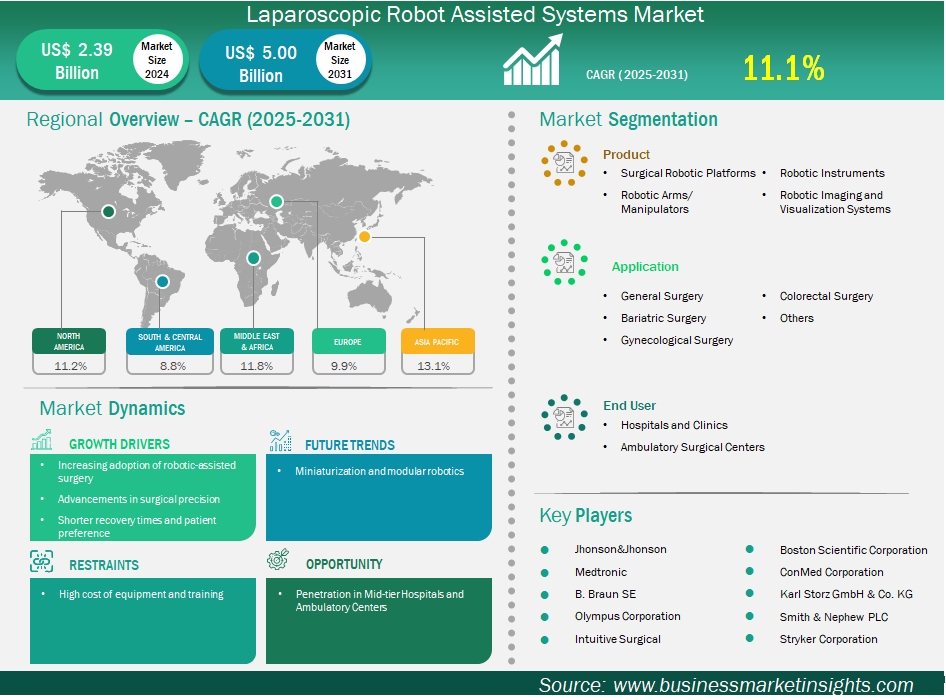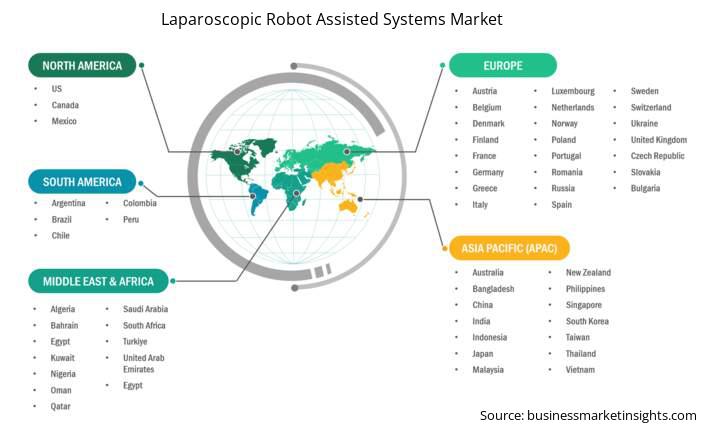Laparoscopic Robot Assisted Systems Market Outlook (2021-2031)
No. of Pages: 200 | Report Code: BMIPUB00031677 | Category: Life Sciences
No. of Pages: 200 | Report Code: BMIPUB00031677 | Category: Life Sciences
The laparoscopic robot assisted systems market size is expected to reach US$ 5,002.32 million by 2031 from US$ 2,387.52 million in 2024. The market is estimated to record a CAGR of 11.1% from 2025 to 2031.
The global laparoscopic robot assisted systems market is experiencing significant growth driven by increasing adoption of robotic-assisted surgery, advancements in surgical precision, and shorter recovery times and patient preference. Laparoscopic robot assisted systems encompasses surgical robotic platforms, robotic arms/manipulators, robotic instruments, and robotic imaging and visualization systems. Robot-assisted surgical systems (RAS) are fundamentally changing surgery practice with unprecedented accuracy, dexterity, and visualization. The rise in popularity can be attributed to their ability to improve patient outcomes; they have been shown to lower blood loss in surgery by 85.3% compared to laparoscopy and 50.5% compared to open surgery.
Globally, the volume of robotic procedures will continue to expand, with more than 12 million da Vinci procedures performed worldwide as of May 2023 and a total of 2.68 million da Vinci procedures completed in 2024 (an 18% increase from the previous year). The integration of AI and machine learning will continue to increase RAS, with respects to enhanced preoperative planning, real-time decision support, and telesurgery, as illustrated by the intercontinental telesurgery, which established a world record in November of 2024, utilizing Microport's Toumai system, by Morocco and This continuous innovation, and the significant benefits that derived from being a patient and surgeon, will solidify RAS' role in the laparoscopic devices market.
Laparoscopic Robot Assisted Systems Market Strategic Insights

Laparoscopic Robot Assisted Systems Market Segmentation Analysis
Key segments that contributed to the derivation of the laparoscopic robot assisted systems market analysis are product, application, and end user.
The growing acceptance of robotic surgery is a key factor driving the growth of the laparoscopic robotic-assisted systems market, as surgeons and health care providers are increasingly embracing robotic platforms for laparoscopic procedures given the improved control, precision, and dexterity they afford, resulting in improved patient outcomes. Laparoscopic robotic-assisted systems provide better range of motion and visualisation than laparoscopy, and are capable of performing complex procedures through small incisions, offering less trauma to the patient and faster recovery.
Robotic-assisted laparoscopic systems are being promoted in a growing number of surgical specialties including, but not limited to urology, gynecology, colorectal surgery, and general surgery. A number of studies have surfaced providing clinical evidence that supports and endorses the efficacy and safety of robotic-assisted laparoscopic techniques - thus encouraging hospitals and surgical centres to offer them. Furthermore, a new trend in reducing hospital stays and other postoperative complications is to entirely utilise and emphasize minimally invasive surgery which is a common approach among robotic systems. In all, robotic systems are becoming an increasingly favourite form of modern surgical care.
The increasing penetration of laparoscopic robotic-assisted systems into mid-tier hospitals and ambulatory surgical centers offers an excellent opportunity to grow the market. Traditionally, high prices and space needed for robotic surgical platforms have limited the number of hospitals that were able to adopt robotic technology for surgical sessions to large, budget-crunched hospitals. However, as innovation continues to unfold, we are starting to see smaller and more affordable robotic systems be available allowing mid-tier healthcare organizations to incorporate robotic-assisted surgical technology into their operational framework. More healthcare providers are looking for ways to enhance surgical efficiency and attract more patients through efficiencies of care and minimally invasive procedures that are associated with laparoscopic robotic-assisted systems.
Similarly, the increasing competition amongst healthcare systems has encouraged mid-tier hospitals to invest in surgical technology and robotics support their surgical service and grow their patient base. The transition and shift of surgical care outside of hospitals and into outpatient settings has been increasingly prioritized as ambulatory surgical centers look for innovations such as robotics to increase processor safety, efficiency and outcomes for their patients. As robotics become accessible to a greater range of healthcare services and intraorganizational facilitators, we can expect to see significant growth in the laparoscopic robotic-assisted systems market.
The laparoscopic robot assisted systems market is classified according to products into surgical robotic platforms, robotic arms/manipulators, robotic instruments, and robotic imaging and visualization systems. The surgical robotic platforms segment led the market in 2024 and beyond. Surgical robotic platforms represent the major product category in the laparoscopic robotic-assisted systems market because they serve as the core infrastructure integrating robotic arms, instruments, and imaging technologies.
In terms of applications, the market is segmented into general surgery, bariatric surgery, gynecological surgery, colorectal surgery, others. The general surgery segment had the largest market share in 2024. General surgery accounts for the largest application segment in the laparoscopic robotic-assisted systems market due to the wide range of common procedures performed using robotic assistance, such as cholecystectomy, hernia repair, and colorectal surgeries. The advantages of robotic systems—improved visualization, precision, and reduced invasiveness—are particularly valuable in general surgery, where delicate tissue handling and complex dissections are often required.
By end user, the market is segmented into hospitals and clinics, and ambulatory surgical centers. The hospitals and clinics segment held the largest share of the market in 2024. Hospitals and clinics are the key end users of laparoscopic robotic-assisted systems as they perform the most of multifaceted surgical procedures and have the set-up to aid the incorporation of cutting-edge robotic technologies. These healthcare set-ups are equipped to capitalize in expensive robotic platforms to improve surgical competences, advance patient results, and rise operative productivity, making them the important end users in this market.
Laparoscopic Robot Assisted Systems Market Report Highlights
Report Attribute
Details
Market size in 2024
US$ 2,387.52 Million
Market Size by 2031
US$ 5,002.32 Million
Global CAGR (2025 - 2031) 11.1%
Historical Data
2021-2023
Forecast period
2025-2031
Segments Covered
By Product
By Application
By End User
Regions and Countries Covered
North America
Europe
Asia-Pacific
South and Central America
Middle East and Africa
Market leaders and key company profiles
The "Laparoscopic Robot Assisted Systems Market Size and Forecast (2021–2031)" report provides a detailed analysis of the market covering below areas:

The geographical scope of the laparoscopic robot assisted systems market report is divided into five regions: North America, Asia Pacific, Europe, Middle East & Africa, and South & Central America. The laparoscopic robot assisted systems market in Asia Pacific is expected to grow significantly during the forecast period.
The Asia Pacific laparoscopic robot assisted systems market consists of China, Japan, India, South Korea, Australia, Bangladesh, New Zealand, Philippines, Singapore, Indonesia, Taiwan, Malaysia, Vietnam, and the Rest of Asia Pacific. The laparoscopic robotic-assisted systems market is expanding considerably within the Asia Pacific region aided by technological advances, increasing healthcare investments and growing demand for minimally invasive surgery. For example, in China, there are over 300 robotic systems installed in more than 250 institutions. These systems are performing over 350,000 procedures annually and especially in urology, where robotic assisted laparoscopic radical prostatectomy is common. Additionally, we are seeing nationally developed robotic platforms emerge in the robotic paradigm, for instance, MicroHand S and SkyWalker, both of which represent cost-effective solutions compared to the globally sourced modern robotic platforms which enable wider access to robotic-assisted surgery. The Indian robotic surgical ecosystem is evolving quickly, with leading medical institutions, such as the All India Institute of Medical Sciences (AIIMS), integrating surgical robots into general surgery departments. Moreover, private investment is growing into robotic surgery projects, and the government is increasingly investing in healthcare modernization projects.
In addition, the Asian nation continues to be a forerunner in robotic surgery, benefitting from broadly government supported robot-assisted surgery integration among clinical practice and healthcare delivery. Beyond India, Japan, for instance, a country with one of the oldest age populations in the world, has a very high demand for robotic assisted surgical procedures to treat chronic diseases. Additionally, South Korea continues to develop its healthcare system with growing investments in minimally invasive technologies. The shift toward preference for minimally invasive procedures is underscored by the rapid increase in the number of robotic surgical procedures, which take place there each year. Collectively, these factors define Asia Pacific as an emerging centre of excellence in the laparoscopic robotic-assisted surgical space.
The laparoscopic robot assisted systems market is evaluated by gathering qualitative and quantitative data post primary and secondary research, which includes important corporate publications, association data, and databases. A few of the key developments in the laparoscopic robot assisted systems market are:
The Laparoscopic Robot Assisted Systems Market is valued at US$ 2,387.52 Million in 2024, it is projected to reach US$ 5,002.32 Million by 2031.
As per our report Laparoscopic Robot Assisted Systems Market, the market size is valued at US$ 2,387.52 Million in 2024, projecting it to reach US$ 5,002.32 Million by 2031. This translates to a CAGR of approximately 11.1% during the forecast period.
The Laparoscopic Robot Assisted Systems Market report typically cover these key segments-
The historic period, base year, and forecast period can vary slightly depending on the specific market research report. However, for the Laparoscopic Robot Assisted Systems Market report:
The Laparoscopic Robot Assisted Systems Market is populated by several key players, each contributing to its growth and innovation. Some of the major players include:
The Laparoscopic Robot Assisted Systems Market report is valuable for diverse stakeholders, including:
Essentially, anyone involved in or considering involvement in the Laparoscopic Robot Assisted Systems Market value chain can benefit from the information contained in a comprehensive market report.